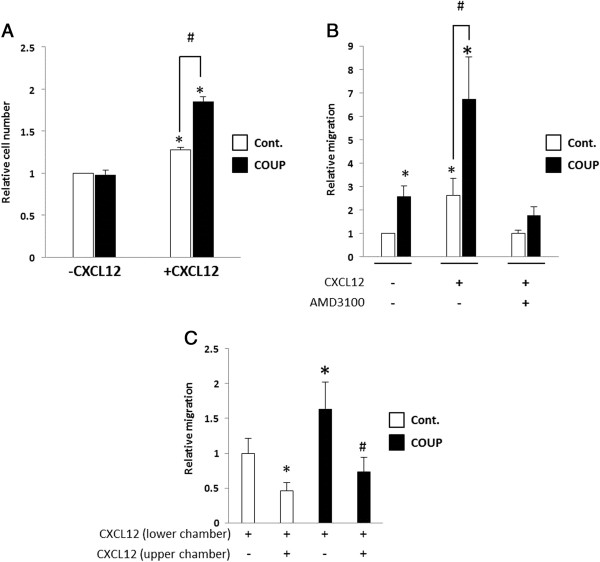Figure 5.

COUP-TFI overexpression influences cellular responses to CXCL12. (A) The relative growth of the control (Cont.) and COUP clones was assayed with or without CXCL12 treatment for 7 days. The basal and CXCL12-induced cell growth were evaluated by MTT assays (n = 6) and determined in three independent experiments. The results are expressed as the relative cell number obtained when the control cells were treated with the vehicle control. Significant differences between the unstimulated control cells and the other conditions (p < 0.05) are indicated with an asterisk. Significant differences between stimulated control cells and stimulated COUP clones (p < 0.05) are indicated with a pound sign. (B) The migratory capacity of control (Cont.) and COUP clones was analyzed. The cells were maintained in phenol red-free DMEM/2.5% dsFBS for 48 h and then seeded in phenol red-free DMEM/0.5% dsFBS in the upper chamber of a PET 8-μm pore insert. The cells were allowed to migrate for 24 h toward the phenol red-free DMEM/2.5% dsFBS medium complemented or not with CXCL12 (200 ng/mL) and AMD3100 (50 μM). (C) CXCL12 was also added to the culture medium in the upper chamber prior to migration. The results are expressed as the mean ± SEM of the relative number of migratory cells compared to the basal migration of the control cells measured in three independent experiments. The asterisks indicate significant differences (p < 0.05) from the basal migration of the control clones. The pound sign indicates significant differences (p < 0.05) between two conditions linked by black lines.
